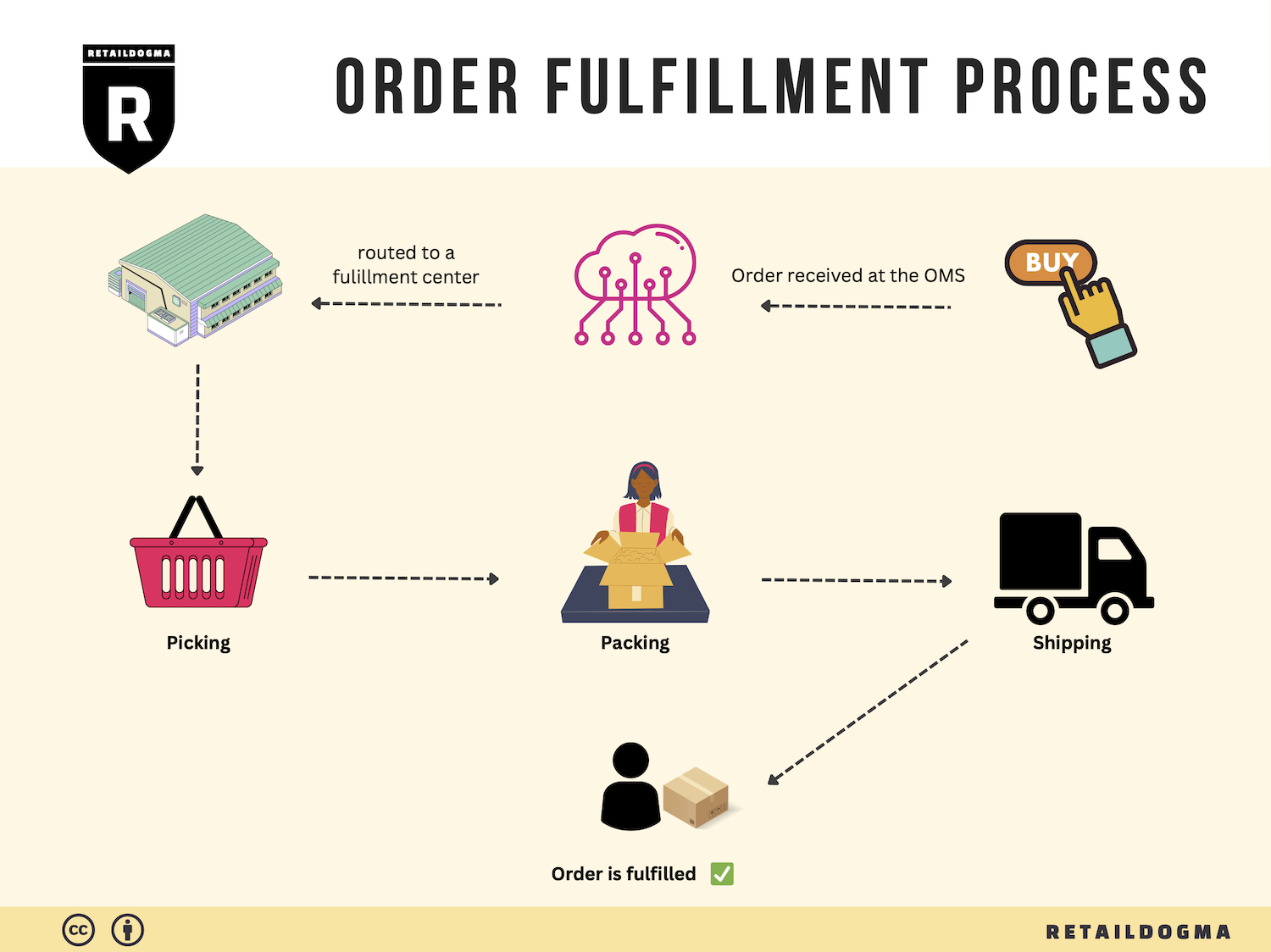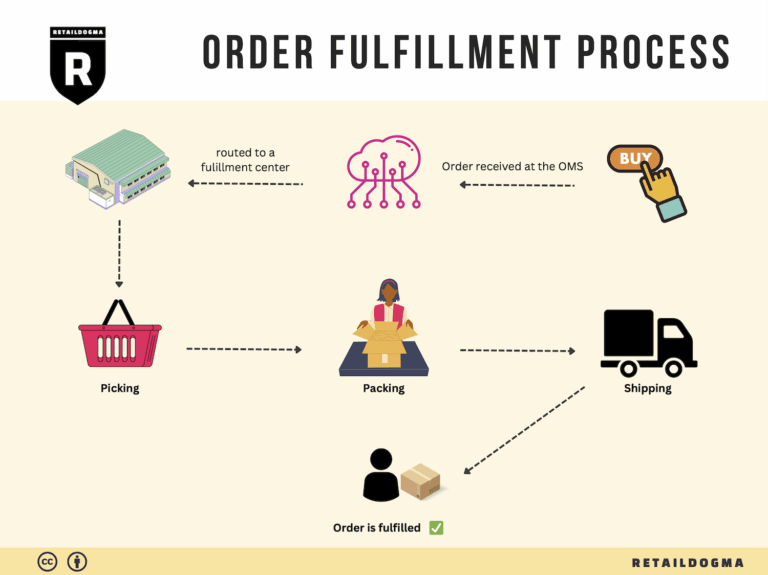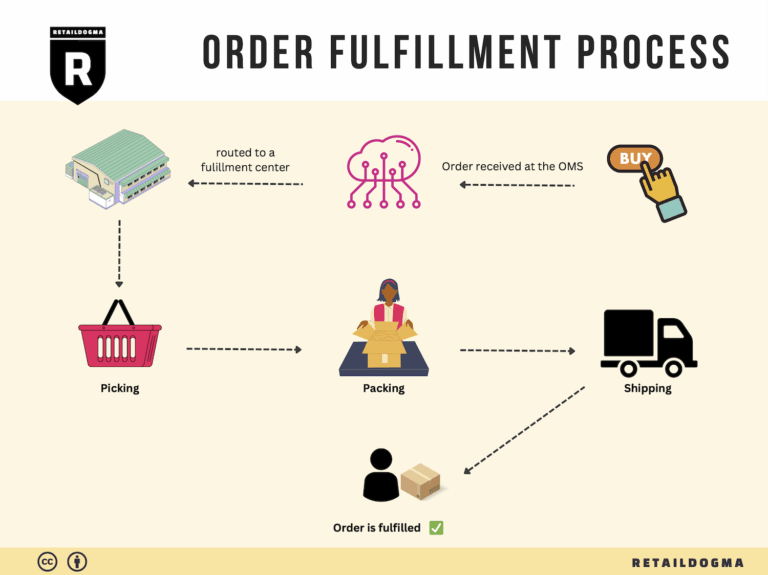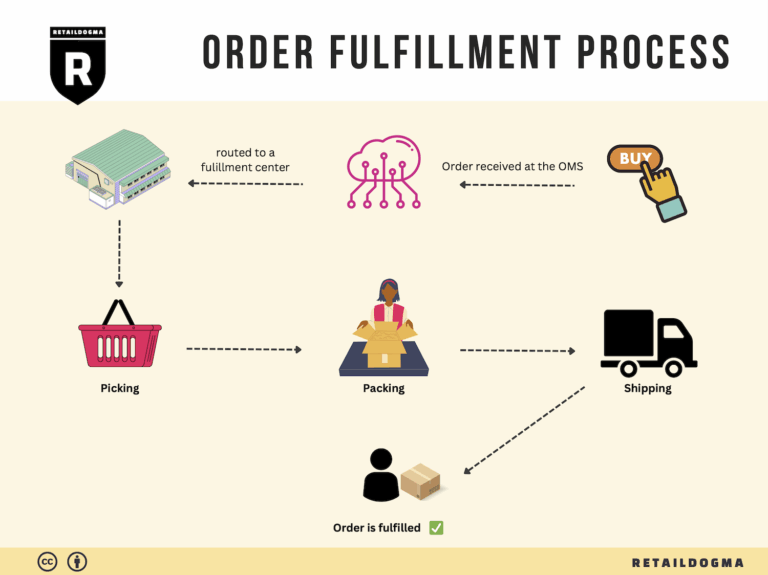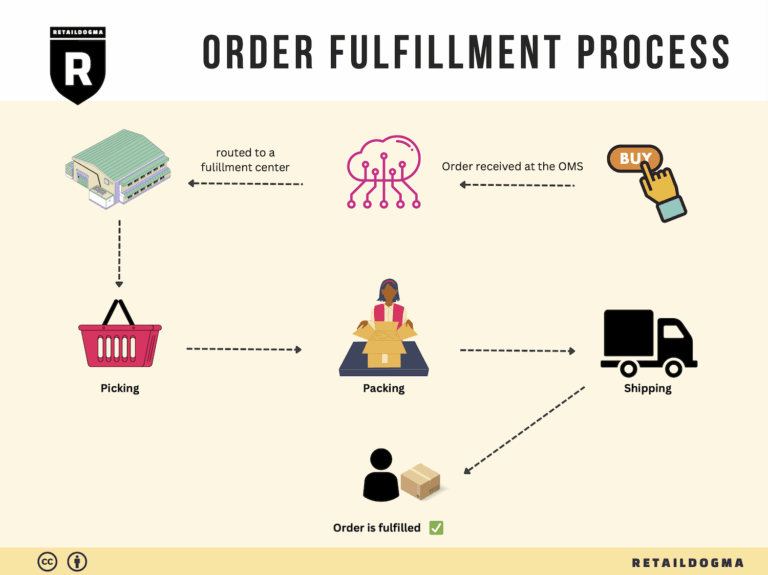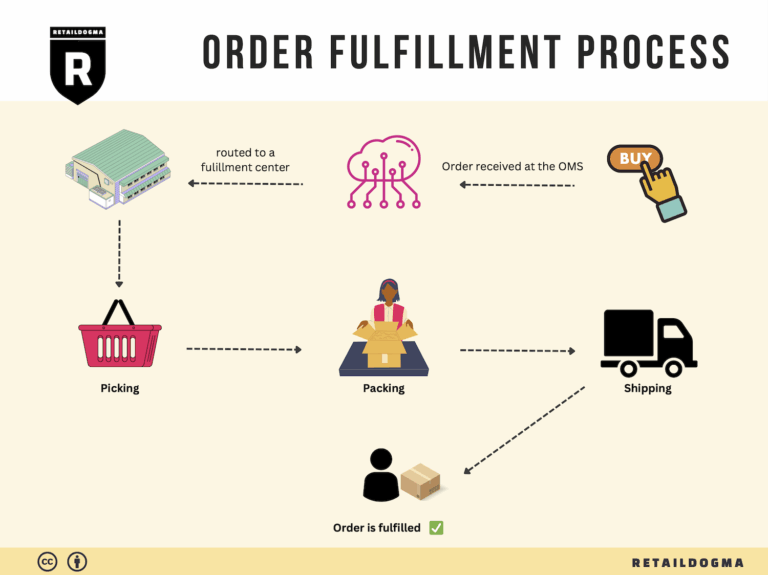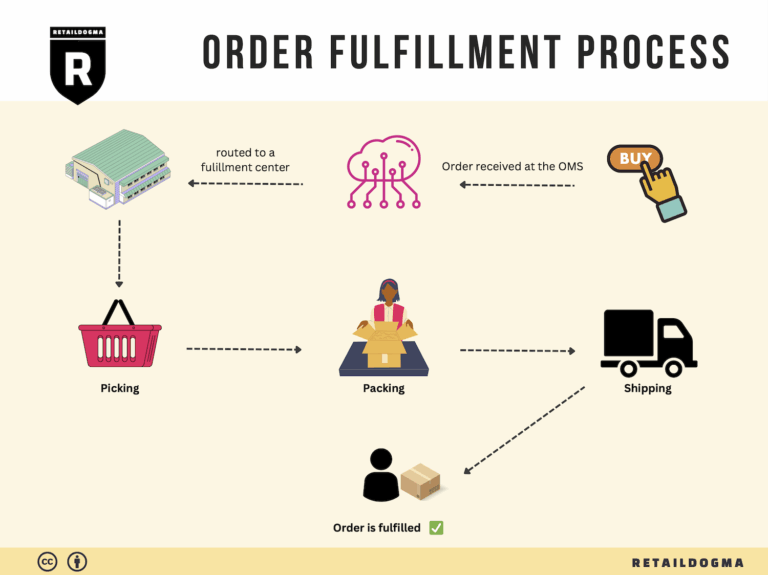Ecommerce Fulfillment Services: The Ultimate Guide (2025)
What is E-commerce Fulfillment? An Introduction for Growing Businesses
Understanding E-commerce Fulfillment
As your e-commerce business scales, you might find yourself grappling with an overwhelming influx of orders. The excitement of growing sales can quickly turn into stress when faced with the manual labor of packing and shipping. This is where e-commerce fulfillment comes into play. Simply put, fulfillment is the comprehensive process of getting a product from your warehouse or storage facility to your customer’s doorstep. It encompasses everything from inventory management to packaging, shipping, and handling returns.
For many growing businesses, managing fulfillment in-house can become a logistical nightmare. The complexities of order processing, inventory tracking, and shipping logistics can distract you from what truly matters—growing your brand and enhancing customer experience. To address these challenges, understanding the various fulfillment models is crucial. This guide will explore key options such as Third-Party Logistics (3PL) and Fulfillment by Amazon (FBA), helping you determine which method best aligns with your business goals.
Additionally, we will delve into the core services typically offered by fulfillment providers. These services include inventory management, order processing, shipping, and returns management. We will also discuss specialized services, such as custom packaging and kitting, which can enhance your brand’s appeal and customer satisfaction.
Choosing the right fulfillment partner is a critical decision that can significantly impact your operational efficiency and customer satisfaction. This guide will provide practical tips on evaluating potential partners, including factors such as their service offerings, technology integration, customer service capabilities, and scalability.
Furthermore, pricing is an essential aspect of fulfillment that can influence your overall profitability. We will break down typical pricing structures, including storage fees, pick and pack charges, and shipping costs, to help you understand how these factors contribute to your bottom line.
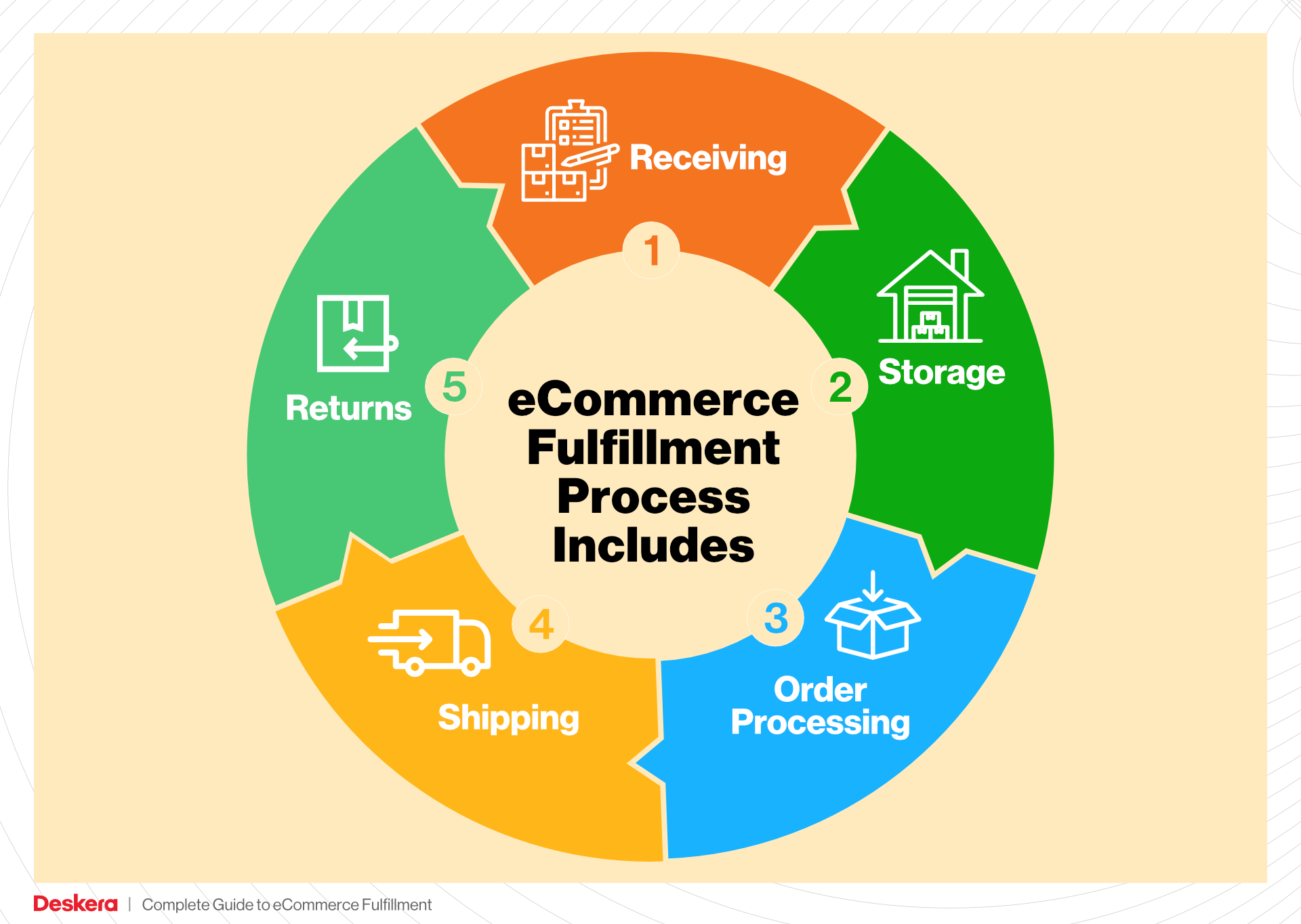
Ultimately, the goal of this guide is to empower you—e-commerce business owners, operations managers, and entrepreneurs—to make informed decisions about your logistics. By understanding the nuances of e-commerce fulfillment, you can streamline your operations, enhance customer satisfaction, and focus on scaling your business effectively.
What You’ll Learn In This Guide
- What is E-commerce Fulfillment? An Introduction for Growing Businesses
- The Order Fulfillment Process: From ‘Buy’ Button to Customer’s Door
- Comparing Fulfillment Models: In-House vs. 3PL vs. Dropshipping
- A Deep Dive into Amazon FBA: Pros, Cons, and Who It’s For
- Core Services Offered by Fulfillment Centers
- How to Choose a Fulfillment Partner: A 6-Point Checklist
- Understanding Fulfillment Pricing: A Breakdown of Common Fees
- Frequently Asked Questions (FAQs) about Fulfillment
- Conclusion: Is Outsourcing Fulfillment the Right Move for Your Business?
- Important Disclaimer
The Order Fulfillment Process: From ‘Buy’ Button to Customer’s Door
1. Receiving Inventory
The order fulfillment process begins with receiving inventory, a critical step that sets the foundation for efficient operations. When products arrive at your fulfillment center, they must be carefully inspected and logged into your inventory management system. This involves verifying quantities, checking for damages, and ensuring that items match the purchase orders.
Importance: Proper receiving processes help maintain inventory accuracy, which is essential for fulfilling customer orders promptly. Discrepancies at this stage can lead to stockouts or overstock situations, directly impacting customer satisfaction and operational efficiency.
Key Term: SKU (Stock Keeping Unit) – A unique identifier for each product that aids in tracking and managing inventory levels throughout the fulfillment process.
2. Warehouse Storage
Once inventory is received and verified, the next step is warehouse storage. Products are organized in a manner that optimizes space and improves accessibility. This can involve shelving, pallet racking, or bins, depending on the type and volume of inventory.
Importance: Effective warehouse storage minimizes the time required to locate products during the picking process, thus enhancing overall efficiency. Well-organized storage also reduces the risk of product damage and ensures that inventory is easy to manage.
Key Term: ABC Analysis – A method of categorizing inventory based on importance and turnover rate, helping businesses prioritize storage space for high-demand items.
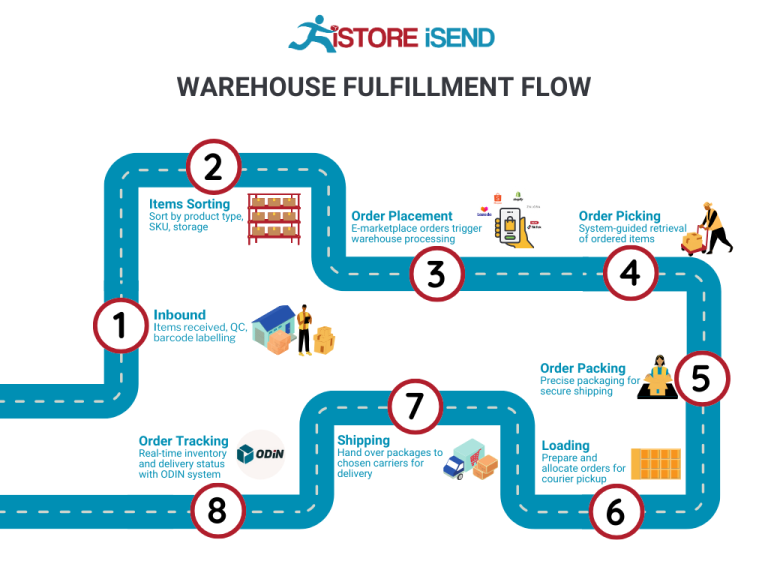
3. Order Picking
The third step in the order fulfillment process is order picking, where items are selected from storage to fulfill customer orders. This can be done using various methods, such as single order picking (one order at a time) or batch picking (multiple orders at once). Pick lists, which are generated based on incoming orders, guide the pickers in selecting the right items.
Importance: Accurate order picking is crucial for ensuring that customers receive the correct products. Errors at this stage can lead to returns and customer dissatisfaction, which ultimately affects your bottom line.
Key Term: Pick Lists – Documents or digital records that specify the items and quantities needed for each order, streamlining the picking process.
4. Order Packing
After items have been picked, they move to the order packing stage. Here, products are carefully packed into shipping boxes, often with protective materials to prevent damage during transit. This step may also involve generating packing slips and ensuring that all items ordered are included in the shipment.
Importance: Proper packing is essential for maintaining product integrity and enhancing the customer experience. A well-packaged order not only protects the items but also reflects positively on your brand, contributing to customer loyalty.
Key Term: Packing Slips – Documents included in the shipment that detail the items and quantities packed, serving as a confirmation for both the seller and the customer.
5. Shipping & Delivery
The final step in the order fulfillment process is shipping and delivery. Once orders are packed, they are labeled and prepared for shipment using a multi-carrier shipping system. This allows businesses to choose the most cost-effective and reliable shipping methods based on customer preferences and delivery speed.
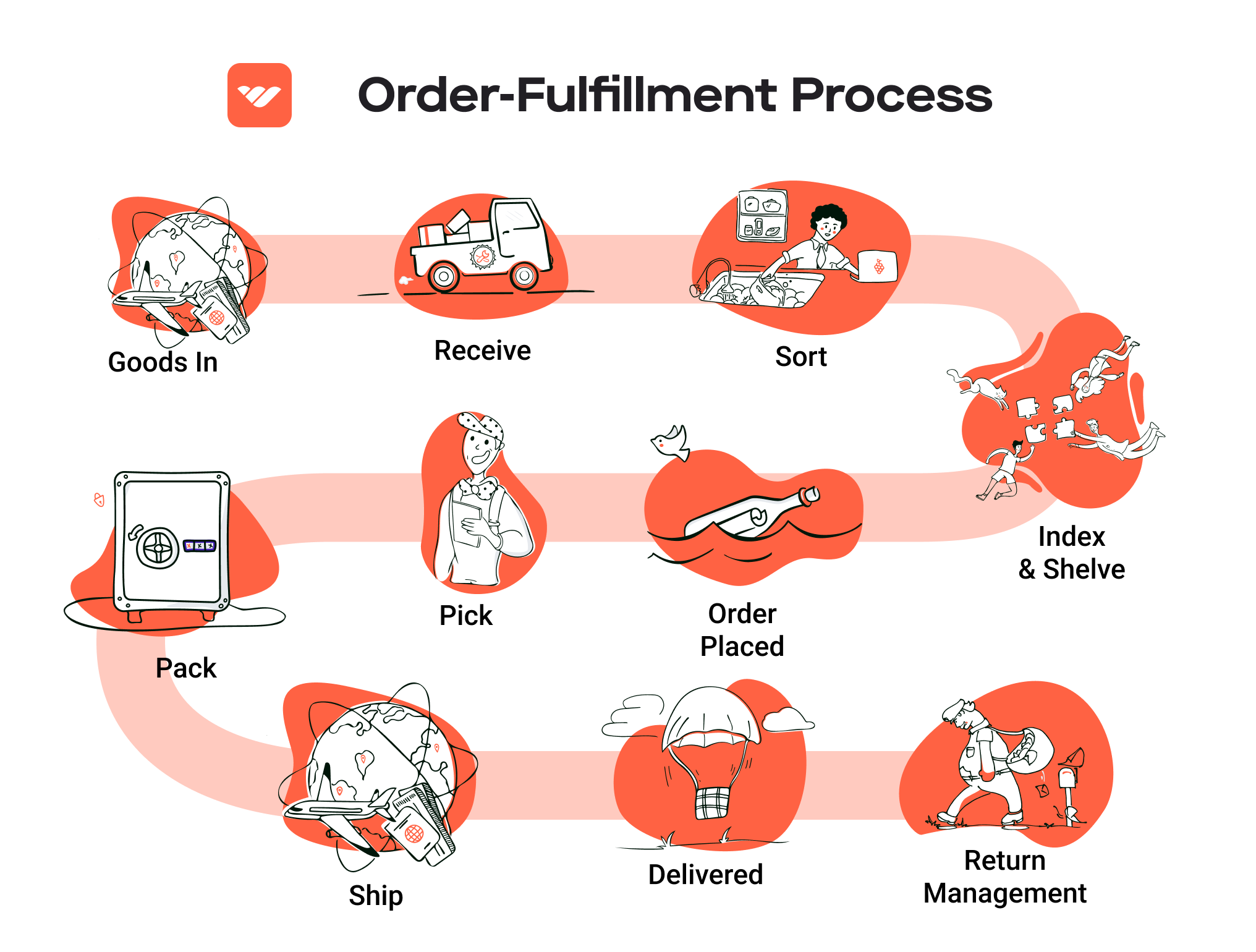
Importance: Timely shipping and delivery are crucial for customer satisfaction. Customers expect their orders to arrive on time, and delays can lead to frustration and loss of trust in your business.
Key Term: Multi-Carrier Shipping – A strategy that utilizes various shipping carriers to optimize delivery times and costs, ensuring the best possible service for customers.
By understanding and effectively managing each of these five steps in the order fulfillment process, e-commerce businesses can significantly enhance their operational efficiency and customer satisfaction. This streamlined approach not only supports scaling efforts but also builds a strong foundation for long-term success in the competitive online marketplace.
Comparing Fulfillment Models: In-House vs. 3PL vs. Dropshipping
Fulfillment Model Comparison
| Model | Who Handles Inventory | Best For (Business Stage) | Key Advantage | Key Disadvantage |
|---|---|---|---|---|
| In-House Fulfillment | Business Owner | Startups to Established | Full control over inventory and processes | High overhead costs and resource requirements |
| Third-Party Logistics (3PL) | 3PL Provider | Growth Stage to Established | Scalability and reduced operational burden | Less control over inventory and fulfillment processes |
| Dropshipping | Supplier | Startups and Small Businesses | Low startup costs and minimal risk | Lower profit margins and potential quality issues |
In-House Fulfillment
In-house fulfillment refers to the process where a business manages its own warehousing and logistics operations. This model allows for complete control over inventory management, order processing, and shipping. For businesses that are just starting out or are well-established, in-house fulfillment can be advantageous because it offers the flexibility to customize the fulfillment process to meet specific customer needs. Companies can ensure quality control, enhance brand integrity, and manage customer service directly. However, the downsides include significant overhead costs associated with maintaining a warehouse, hiring staff, and investing in technology. Furthermore, as order volumes increase, businesses may find it challenging to scale operations efficiently without incurring additional costs.
Third-Party Logistics (3PL)
Third-party logistics (3PL) providers, such as Sisk Fulfillment Services, handle various aspects of the supply chain, including warehousing, inventory management, and order fulfillment on behalf of e-commerce businesses. This model is ideal for businesses in the growth stage or those that have reached a point where managing logistics in-house is no longer feasible. A key advantage of using a 3PL provider is the ability to scale operations quickly without the need for significant capital investment. 3PLs typically offer expertise in logistics, advanced technology for tracking and inventory management, and the ability to access a broader range of shipping options, which can reduce costs. However, businesses may experience less control over their inventory and fulfillment processes, which can lead to potential discrepancies in service quality and customer experience.
Dropshipping
Dropshipping is a fulfillment model in which the retailer does not keep products in stock but instead transfers customer orders and shipment details to a manufacturer, wholesaler, or another retailer who then ships the goods directly to the customer. This model is particularly beneficial for startups and small businesses as it requires minimal upfront investment and eliminates the risks associated with holding inventory. Retailers can offer a wide variety of products without the need for a physical warehouse, making it an attractive option for those looking to test new markets or product lines. However, dropshipping comes with its challenges. Profit margins tend to be lower since retailers rely on suppliers for fulfillment, and there can be issues with product quality, shipping times, and inventory availability. Additionally, the lack of control over the fulfillment process can lead to customer dissatisfaction if the supplier fails to meet expectations.
In summary, each fulfillment model presents unique advantages and challenges. E-commerce business owners should carefully evaluate their current needs, growth projections, and available resources to determine the most suitable fulfillment strategy for their operations. By aligning their fulfillment model with their business objectives, they can enhance efficiency, improve customer satisfaction, and ultimately drive growth.
A Deep Dive into Amazon FBA: Pros, Cons, and Who It’s For
Understanding Fulfillment by Amazon (FBA)
Fulfillment by Amazon (FBA) is a service provided by Amazon that allows sellers to store their products in Amazon’s fulfillment centers. Once a product is sold, Amazon takes care of storage, packaging, shipping, and customer service on behalf of the seller. This service is particularly appealing to e-commerce businesses looking to streamline their operations and leverage Amazon’s vast logistics network.
How FBA Works
-
Setup: Sellers create an Amazon seller account and enroll in the FBA program. They then prepare their products according to Amazon’s guidelines and ship them to designated fulfillment centers.
-
Storage: Products are stored in Amazon’s warehouses, where they are organized and inventoried. Amazon manages the logistics of maintaining inventory levels.
-
Order Fulfillment: When a customer places an order for a seller’s product, Amazon picks, packs, and ships the item directly to the customer. This process typically includes printing shipping labels and handling returns.
-
Customer Service: Amazon also manages customer inquiries and returns, providing support that adheres to their customer service standards.
-
Payment: After the sale, Amazon deducts fees for storage and fulfillment from the sale price before transferring the remaining funds to the seller.
Pros of Using FBA
1. Prime Eligibility
One of the most significant advantages of FBA is that products fulfilled through this service are eligible for Amazon Prime. This means that Prime members can receive their orders with free two-day shipping, making the products more attractive to a vast customer base. This eligibility can significantly increase sales, as many consumers prefer Prime-eligible items.
2. Customer Trust
Amazon is a trusted brand with a strong reputation for customer service. By using FBA, sellers can leverage this trust. When customers see that a product is fulfilled by Amazon, they often feel more secure in their purchasing decision. This can lead to higher conversion rates and repeat business.
3. Multi-Channel Fulfillment
FBA is not limited to sales on Amazon alone. Sellers can also use FBA to fulfill orders from other sales channels, such as their own websites or other e-commerce platforms. This multi-channel fulfillment capability allows businesses to centralize their inventory and streamline operations, reducing complexity and improving efficiency.
Cons of Using FBA
1. High Fees
While FBA offers many benefits, it also comes with costs. Sellers face various fees, including monthly storage fees and per-unit fulfillment fees. These costs can add up quickly, particularly for businesses with low-margin products. It’s essential for sellers to thoroughly calculate these fees to ensure profitability.
2. Strict Inventory Rules
Amazon has stringent inventory management rules that sellers must adhere to. This includes guidelines on product preparation, labeling, and shipping. Any discrepancies can lead to delays in processing or additional charges. Sellers need to invest time and resources to ensure compliance, which can be a burden, especially for smaller businesses.
3. Commingling Risks
FBA operates on a commingling model, which means that inventory from different sellers can be stored together. While this can streamline operations, it also poses risks. If a seller’s product is damaged or if there are quality control issues with another seller’s inventory, it could affect the reputation of all products in that batch. Sellers must be vigilant and monitor their performance metrics closely.
Who is FBA Best For?
Fulfillment by Amazon is best suited for a variety of e-commerce businesses, particularly those looking to scale. Here are some types of sellers who may benefit most from FBA:
-
Startups and Small Businesses: Entrepreneurs who want to focus on growing their business without getting bogged down by logistics can benefit significantly from FBA. The service allows them to leverage Amazon’s infrastructure without needing to invest heavily in their own warehousing and fulfillment operations.
-
Brands with High Sales Volume: Businesses that already have a solid sales volume can take advantage of FBA’s efficiencies. The ability to store large quantities of inventory at Amazon’s facilities can lead to faster fulfillment and happier customers.
-
Sellers of Unique or Niche Products: If a seller offers unique or niche products that require specialized handling, FBA can help manage the logistics and customer service, allowing them to focus on product development and marketing.
-
Businesses Seeking to Enter the Amazon Marketplace: For sellers who are new to the Amazon platform, FBA provides an excellent opportunity to enter the marketplace with less risk. It simplifies the logistics of selling on Amazon and can help build a customer base quickly.
In conclusion, while Fulfillment by Amazon offers a range of advantages that can significantly benefit e-commerce businesses, it also presents challenges that sellers must navigate. Understanding these dynamics is crucial for any business looking to leverage FBA as part of their growth strategy. By carefully weighing the pros and cons, sellers can make informed decisions that align with their operational goals and customer service standards.
Core Services Offered by Fulfillment Centers
Inventory Management & Warehousing
Inventory management and warehousing are foundational services provided by fulfillment centers that allow e-commerce businesses to streamline their supply chain processes. This involves the systematic tracking of inventory levels, orders, sales, and deliveries. Fulfillment centers typically offer advanced inventory management systems that provide real-time data on stock levels, helping businesses avoid stockouts or overstock situations.
The benefits of effective inventory management are manifold. Firstly, it enhances operational efficiency by reducing the time spent on manual inventory checks and enabling automated reordering processes. This ensures that businesses maintain optimal stock levels, thereby meeting customer demand without incurring unnecessary holding costs. Moreover, accurate inventory data helps in forecasting demand, allowing businesses to plan better for seasonal spikes or promotional campaigns. By utilizing a fulfillment center’s warehousing capabilities, e-commerce businesses can also benefit from strategically located storage spaces, which can reduce shipping times and costs, ultimately leading to improved customer satisfaction.
Pick and Pack Services
Pick and pack services are vital components of the fulfillment process, particularly for e-commerce businesses that receive a high volume of individual orders. This service involves the selection (or “picking”) of products from the warehouse based on customer orders and then packaging (or “packing”) those items for shipment. Fulfillment centers employ trained staff and advanced technologies, such as barcode scanners and automated systems, to ensure accuracy and efficiency in this process.
The primary benefit of pick and pack services is enhanced order accuracy, which directly impacts customer satisfaction. Mistakes in order fulfillment can lead to returns, negative reviews, and loss of customer loyalty. By utilizing a fulfillment center’s pick and pack services, e-commerce businesses can significantly reduce errors, ensuring that the right products are sent to the right customers. Additionally, these services can provide faster turnaround times, as fulfillment centers often have dedicated teams that work around the clock to meet order deadlines. This agility allows businesses to scale their operations without the need for significant investments in labor or technology.
Kitting and Assembly
Kitting and assembly refer to the process of grouping individual items together into ready-to-ship kits or packages. This service is especially beneficial for businesses that offer subscription boxes, promotional bundles, or multi-item purchases. Fulfillment centers can handle everything from simple assembly tasks to complex kitting projects, ensuring that products are packaged in a way that enhances the customer experience.
The advantages of kitting and assembly services are substantial. For one, they allow e-commerce businesses to present their products in an attractive and organized manner, which can improve perceived value and customer satisfaction. Additionally, pre-assembled kits can reduce shipping costs by optimizing space within shipping boxes and minimizing the number of shipments needed. This service also enables businesses to respond quickly to market trends or customer preferences by allowing for rapid adjustments to product offerings without the need for extensive retooling of internal processes. By outsourcing kitting and assembly, businesses can focus more on marketing and sales, knowing that their fulfillment center is efficiently managing the logistics.
Returns Management (Reverse Logistics)
Returns management, also known as reverse logistics, is an essential service offered by fulfillment centers that allows businesses to efficiently handle product returns. This process includes the receiving, inspecting, restocking, or disposing of returned items. Effective returns management is critical for maintaining customer satisfaction and loyalty, as a smooth return process can significantly influence a customer’s perception of a brand.
The benefits of a robust returns management system are numerous. It provides e-commerce businesses with the capability to handle returns swiftly and efficiently, minimizing the impact on inventory and cash flow. A well-managed returns process can also help businesses identify patterns in returns, such as defective products or misaligned customer expectations, providing valuable insights that can inform product development and marketing strategies. Furthermore, by leveraging the expertise of a fulfillment center, businesses can ensure that their returns process adheres to best practices, reducing costs associated with handling returns and improving overall operational efficiency. This is particularly important in today’s e-commerce landscape, where customer expectations for hassle-free returns are higher than ever.
In summary, fulfillment centers offer a suite of core services that are crucial for e-commerce businesses looking to scale their operations effectively. From inventory management to returns handling, these services provide the necessary infrastructure and expertise that allow businesses to focus on growth while ensuring a seamless customer experience.
How to Choose a Fulfillment Partner: A 6-Point Checklist
Location & Warehouse Network
The geographic location of your fulfillment partner’s warehouses can significantly impact shipping times and costs. A partner with strategically placed warehouses can provide faster delivery to your customers, which is crucial for maintaining high satisfaction levels.
Questions to Ask:
– Where are your warehouses located, and how do these locations align with my customer base?
– Do you have a network of warehouses that can support my distribution needs?
– How do you handle shipping to remote or international locations?
Technology & Integrations
In today’s e-commerce landscape, technology plays a vital role in streamlining operations. A fulfillment partner should offer robust technology solutions that integrate seamlessly with your e-commerce platform, inventory management system, and customer relationship management tools.
Questions to Ask:
– What technology solutions do you use for order management, inventory tracking, and shipping?
– Can your systems integrate with my existing e-commerce platform (e.g., Shopify, WooCommerce)?
– Do you provide real-time tracking for orders, and how accessible is this information for my customers?
Specializations (e.g., Cold Storage, Oversized Items)
Different businesses have unique fulfillment needs. If you deal with specialized products—such as perishable goods, oversized items, or fragile items—it’s crucial to partner with a fulfillment provider that has the necessary capabilities and expertise.
Questions to Ask:
– What types of products do you specialize in fulfilling?
– Do you have the necessary certifications (e.g., FDA compliance for dietary supplements) to handle my products?
– How do you manage the storage and shipping of items that require special handling (e.g., temperature control)?
Scalability & Capacity
As your business grows, your fulfillment needs will evolve. A good fulfillment partner should have the capacity to scale operations alongside your growth, ensuring they can handle increases in order volume without compromising service quality.
Questions to Ask:
– How do you manage seasonal fluctuations in order volume?
– What processes do you have in place for scaling your operations as my business grows?
– Can you provide examples of how you’ve managed growth for other clients?
Pricing and Contracts
Understanding the pricing structure and contract terms is essential for budgeting and financial planning. A transparent pricing model that aligns with your business goals will help prevent unexpected costs down the line.
Questions to Ask:
– Can you provide a detailed breakdown of your pricing model (e.g., per order, per item, storage fees)?
– What are the terms of your contracts, and is there flexibility for renegotiation?
– Are there any additional fees I should be aware of (e.g., for returns, special handling, or seasonal surcharges)?
Customer Support & Reviews
Quality customer support is crucial for addressing issues that may arise during the fulfillment process. Additionally, researching a partner’s reputation through customer reviews can provide valuable insights into their reliability and service quality.
Questions to Ask:
– What kind of customer support do you offer (e.g., dedicated account manager, 24/7 support)?
– How do you handle issues or discrepancies in orders?
– Can you provide references or testimonials from current or past clients?
Conclusion
Choosing the right fulfillment partner is a critical decision that can influence your business’s operational efficiency and customer satisfaction. By carefully evaluating potential partners against this checklist, you can make an informed decision that aligns with your business goals and customer needs. Prioritize a partner that not only meets your logistical requirements but also complements your overall business strategy.
Understanding Fulfillment Pricing: A Breakdown of Common Fees
Initial Setup Fees
Initial setup fees are typically charged at the beginning of a fulfillment partnership to cover the costs associated with onboarding a new client. This can include the configuration of your products in the fulfillment system, integration with your e-commerce platform, and any necessary training for your team. The fee can vary widely based on the complexity of your operations and the level of customization required.
To calculate this fee, fulfillment providers often consider factors such as:
- The number of products being set up.
- The complexity of your inventory management needs (e.g., variations in size, weight, or packaging).
- Integration requirements with existing e-commerce systems.
It’s essential to clarify what is included in the setup fee and to ensure that you understand any ongoing costs that may arise post-setup.
Receiving Fees
Receiving fees are charged for the process of accepting and inspecting incoming inventory. These fees typically cover the labor and resources needed to unload shipments, check products for quality, and input them into the inventory management system.
This fee is usually calculated based on:
- The number of pallets or boxes received.
- The time taken to process each shipment.
- The complexity of the products being received (e.g., bulk vs. individual items).
For businesses with frequent shipments, it’s advisable to negotiate a flat rate or bulk discount on receiving fees to better manage costs.
Storage Fees (per pallet/bin)
Storage fees are a recurring cost associated with keeping your inventory in the fulfillment center. These fees are typically charged on a monthly basis and can be calculated per pallet or per bin, depending on how your products are stored.
The calculation of storage fees can depend on:
- The size of the pallets or bins used.
- The duration of storage (some providers offer tiered pricing based on the length of time inventory is stored).
- The total volume of inventory being stored.
Understanding your inventory turnover rate can help you estimate storage costs more accurately. If your products have a slower turnover, you may want to discuss options for reducing storage fees, such as improving sales strategies or utilizing seasonal storage solutions.
Pick & Pack Fees (per item/order)
Pick and pack fees are charged for the labor involved in retrieving items from storage and packing them for shipment. This fee can vary based on the complexity of the order and the number of items being picked.
Key factors influencing pick and pack fees include:
- The number of items in each order (bulk orders may have a different pricing structure).
- The type of packing required (simple boxes vs. custom packaging).
- Any additional services, such as gift wrapping or including promotional materials.
To ensure you’re receiving fair pricing, consider getting estimates from multiple providers and discussing potential volume discounts.
Shipping Fees
Shipping fees encompass the costs associated with transporting your products from the fulfillment center to your customers. This can include carrier fees, handling charges, and packaging materials. Shipping fees can vary based on:
- The destination of the shipment (domestic vs. international).
- The shipping method selected (standard, expedited, etc.).
- The weight and dimensions of the package.
Many fulfillment centers have partnerships with various carriers, which can provide you with discounted rates. It’s advisable to discuss these options upfront to ensure you’re getting the best shipping rates possible.
Tips for Getting an Accurate Quote
-
Be Transparent: Provide potential fulfillment partners with as much detail as possible about your business, including product types, order volumes, and any special requirements. This will help them give you a more accurate estimate.
-
Request Itemized Quotes: Ask for a breakdown of all fees involved in the fulfillment process. This should include initial setup, receiving, storage, pick & pack, and shipping fees.
-
Compare Multiple Providers: Don’t settle for the first quote. Comparing multiple fulfillment providers can help you understand the market rate and find the best fit for your needs.
-
Negotiate Terms: Once you have your quotes, don’t hesitate to negotiate terms. Many fulfillment centers are open to adjusting their pricing based on volume or long-term commitments.
-
Understand the Fine Print: Be sure to read the contract carefully. Look for any potential hidden fees or terms that could affect your overall costs.
By understanding these common fees and how they are calculated, you can make informed decisions that will help streamline your operations and support your business’s growth.
Frequently Asked Questions (FAQs) about Fulfillment
1. What is Sisk Fulfillment Service Inc.?
Sisk Fulfillment Service Inc. is a comprehensive third-party logistics (3PL) provider specializing in fulfillment services for e-commerce businesses, membership organizations, and subscription services. Founded in 1983, Sisk combines the personalized customer service of a small company with the efficiency and volume capabilities of a large enterprise.
2. What types of fulfillment services does Sisk offer?
Sisk offers a diverse range of fulfillment services, including:
– Dietary Supplement Fulfillment: Compliant with FDA regulations and focused on quality control.
– Membership Premium Fulfillment: Handling literature, certificates, and member kits for organizations.
– Subscription Premium Fulfillment: Supporting publishers with subscriber communications and product shipping.
– Personalized Acknowledgment Fulfillment: Creating tailored thank-you letters and certificates for donors and members.
– eCommerce Pick-n-Pack Fulfillment: Ensuring accuracy and flexibility for online orders.
– Custom Kit Assembly: Building complex kits tailored to client specifications.
3. How does Sisk ensure order accuracy?
Sisk employs a multi-step process to ensure order accuracy, which includes:
– Utilizing barcodes and handheld scanners.
– Implementing a manual “3-step check” system.
– Printing individual packing slips or invoices with the client’s logo.
– Assigning dedicated Pick-n-Pack teams trained to handle catalog orders with care.
4. What is the difference between a warehouse and a fulfillment center?
A warehouse primarily focuses on storing goods, while a fulfillment center is designed to manage the entire order fulfillment process. Fulfillment centers handle receiving, storing, picking, packing, and shipping products directly to customers. In contrast, warehouses may not be equipped for the logistics of order processing and shipping.
5. What is a 3PL?
A third-party logistics provider (3PL) is a company that offers outsourced logistics services, including warehousing, fulfillment, and transportation. By partnering with a 3PL like Sisk, businesses can focus on their core operations while leveraging the expertise and resources of the logistics provider to manage their supply chain.
6. How much do fulfillment services cost?
Fulfillment service costs can vary widely based on factors such as order volume, storage space, and specific service requirements. Sisk typically provides customized pricing based on your unique needs. It’s advisable to contact them for a tailored quote that reflects your business operations.
7. What are the benefits of using Sisk Fulfillment Service?
Key benefits of partnering with Sisk include:
– Expertise: Over 35 years of experience in fulfillment and logistics.
– Scalability: Ability to handle both small and large order volumes efficiently.
– Compliance: Adherence to FDA regulations for dietary supplements.
– Customer Service: Dedicated teams focused on exceeding client expectations.
– Customization: Tailored solutions for diverse fulfillment needs.
8. How does Sisk handle returns management?
Sisk offers a comprehensive returns management service, allowing businesses to efficiently process returned items. This includes handling inspections, restocking, and managing inventory adjustments, ensuring that the return process is seamless for both the business and its customers.
9. Can Sisk manage my eCommerce fulfillment?
Yes, Sisk specializes in eCommerce fulfillment and is equipped to handle unique order requirements for online sales. They provide flexible solutions that include order picking, packing, and shipping, ensuring timely delivery while maintaining high accuracy levels.
10. How can I get started with Sisk Fulfillment Service?
To begin working with Sisk Fulfillment Service, you can reach out directly through their website or contact them via phone or email. They will discuss your fulfillment needs, provide you with a customized quote, and guide you through the onboarding process to ensure a smooth transition.
Conclusion: Is Outsourcing Fulfillment the Right Move for Your Business?
Key Benefits of Outsourcing Fulfillment
Outsourcing your fulfillment needs can be a transformative decision for e-commerce businesses aiming to scale efficiently. One of the primary advantages is time savings. By partnering with a specialized fulfillment service like Sisk Fulfillment Service Inc., you can delegate the time-consuming tasks of inventory management, order processing, and shipping. This allows you to focus on core business activities such as marketing and customer engagement, ultimately driving growth.
Another significant benefit is scalability. As your business grows, so do your fulfillment needs. Fulfillment services are equipped to handle fluctuating order volumes, seasonal spikes, and expanding product lines without the need for substantial investment in infrastructure or labor. This flexibility ensures that you can respond quickly to market demands while maintaining high service levels.
Additionally, leveraging the expertise of a dedicated fulfillment partner means accessing advanced systems, technology, and best practices that may not be feasible in-house. With established processes and compliance certifications, a fulfillment service can enhance accuracy, reduce errors, and improve overall customer satisfaction.
Choosing the Right Partner for Growth
While the benefits are compelling, it’s crucial to choose the right fulfillment partner that aligns with your business goals. Look for a provider with a proven track record, comprehensive service offerings, and a commitment to customer service. A partner like Sisk, which combines personalized attention with high-volume efficiency, can be instrumental in your journey toward sustainable growth.
Take Action
To determine if outsourcing fulfillment is the right move for your business, conduct a thorough audit of your current shipping and logistics processes. Evaluate your order accuracy, shipping times, and resource allocation. Consider whether a fulfillment partner could enhance your operational efficiency and customer satisfaction. If the answer is yes, it may be time to explore your options and take the next step toward scaling your business with a trusted fulfillment partner.
Important Disclaimer
⚠️ Important Disclaimer
The information in this guide is for educational purposes. Fulfillment services, pricing, and platform features change frequently. Always conduct your own due diligence and consult with providers directly before making business decisions.
